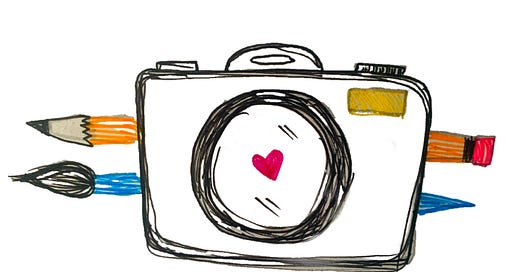Abstract meaning and feeling in art is largely rooted in associations: abstract elements (such as colors, shapes, and symbols) are associated with something more tangible, which is associated with memories -which have feelings connected to them. Though some believe that there are collective or objective meanings for abstract elements (such as colors, shapes, and symbols), what that meaning might be is often debated due to differences in culture and personal experience. For that reason, artists use abstract elements to express themselves in different ways, and the impact of art on the viewer can vary based on cultural and personal experiences.
That being said, abstract meaning is not something that can easily be understood through the intellect; it’s more of a feeling (that can change depending on our mood and our background).
With that in mind, let’s exercise our ability to express and relate to the world abstractly:
Color Psychology & Symbolism
Color Psychology1 studies the associations and effects that color has on behavior, mood, and feelings. Color symbolism is the use of color in literature to convey mood or abstract meaning2.
To get to know your own color psychology, consider: What color(s) would you use to express fear? Happiness? Sadness? Anger? A warm-heart? Serenity? Take your reflection deeper with one or both of the following creative practices:
Color Art
Create a piece of art that only uses color (no lines or shapes) for each of the feelings listed above. Notice:
How does the value (ie how light or dark the color is) affect the feeling?
How does the saturation (or intensity) of color affect the feeling?
How do different shades of color affect the feeling?
How do contrasting colors affect the feeling?
Color Poem
Write a poem that’s titled: “I Am [color of your choice]” or “I Feel [color of your choice]”
Color in Nature
Watch these videos from John Muir Laws (worldwide leader in nature journaling) about using color in nature journaling:
→ Using Color Pencil in Nature Drawings
Shape Psychology
Shapes are the geometric forms that make the bones of the world around us. They’re everywhere and in everything. Shape psychology and shape symbolism look at how different shapes affect us subconsciously, as well as how they can be used to express abstract feeling or meaning.
→ To get to know your own shape psychology, write a few shape poems, titled: “I Am [shape of your choice]” or “I Feel [shape of your choice]”
→ Practice seeing and using shapes in nature journaling with this video: Drawing with Shapes in Nature
Texture
Different textures also conjure up different feelings and emotions.
→ Consider: What associations or emotions arise when you think about something rough? Smooth? Sharp? Soft? Hard? Sticky? Slimy? Write a few texture poems, titled: “I Am [texture of your choice]” or “I Feel [texture of your choice]”
→ Practicing seeing and using texture in nature journaling with this video: Creating Texture in Your Nature Art
Check Out More Visual Poetics for Reflective Arts:
Read More About the Foundations of Reflective Art with:
The Heart of Reflective Arts: for peace within and all around
https://blog.colornavigator.net/color-psychology#:~:text=Colors%20have%20different%20meanings%20in,%2Daggression%2C%20universality%20and%20calm.
https://www.masterclass.com/articles/color-symbolism-in-literature




